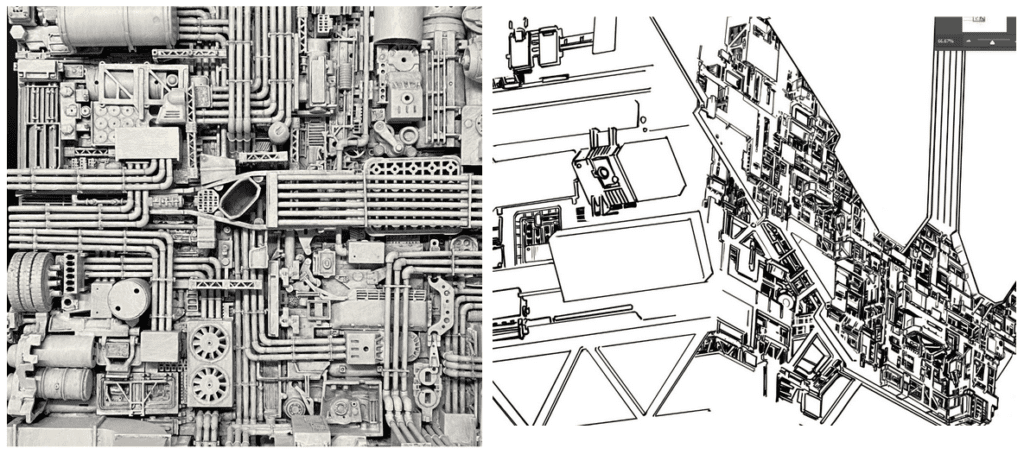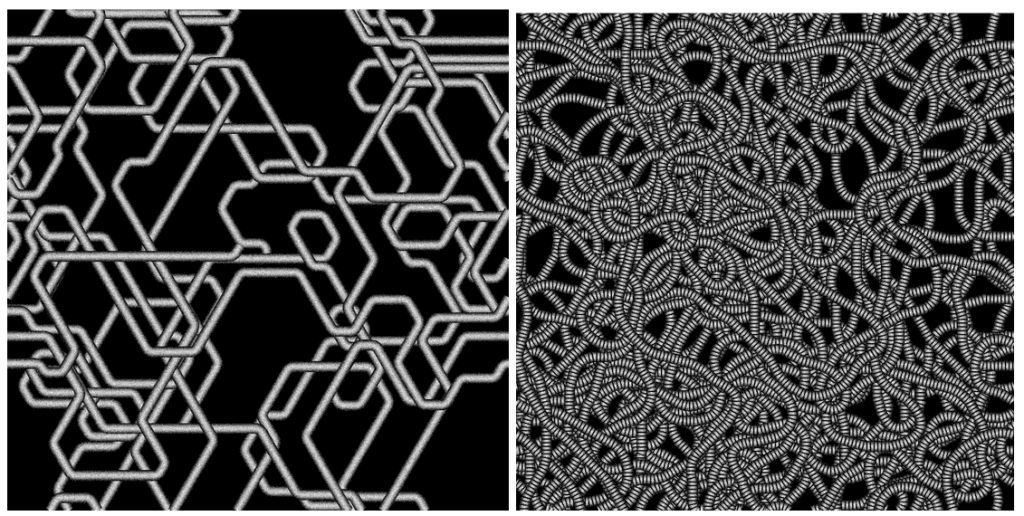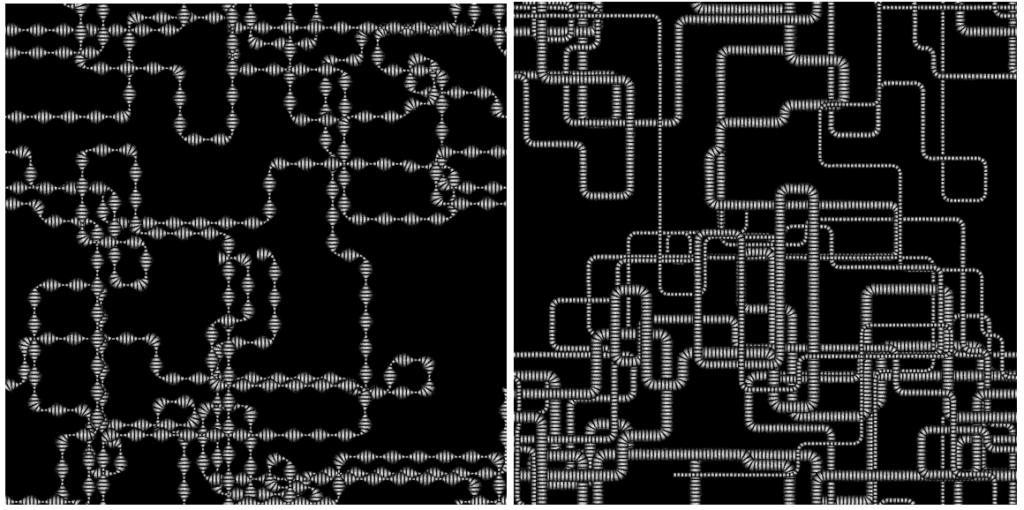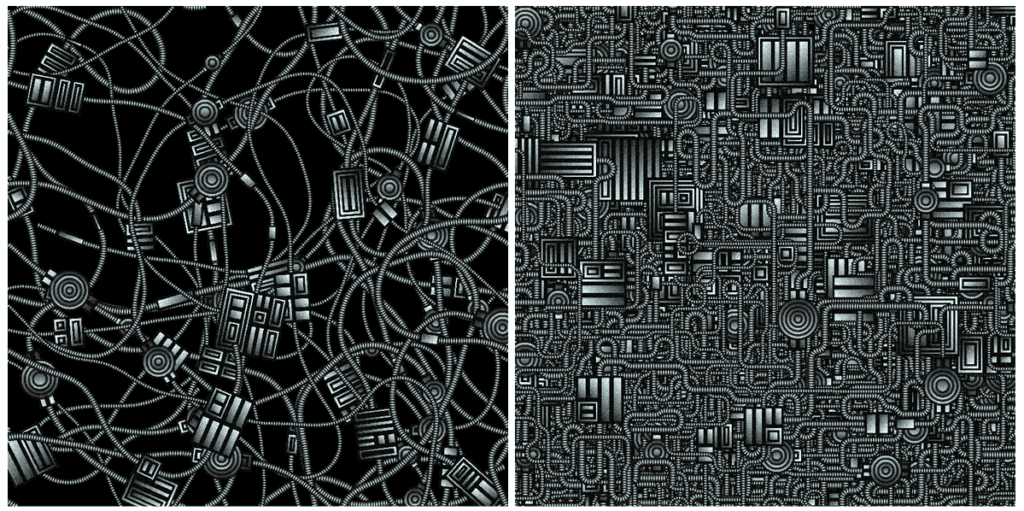762 Unique editions. See on Artblocks.io
UMK [Ultra Mechanika]: Beyond technology.
Imagine a world where technology not only advances mechanically, but also adapts and changes in response to its environment.
In this view, machines could evolve into a variety of forms, from biological and organic to architectural and industrial, each with its own unique capabilities and characteristics.
The UMK algorithm could be thought of as a life form that has evolved from a seed. Its DNA defines the way in which it grows and develops, and once it reaches maturity, it begins to communicate with other life forms and spread its seeds across the universe.

UMK expands my previous explorations of the interaction between humans and technology, as seen in my Defrag Trilogy featured on fxhash.
This time, I delve into the idea of a world where human intervention is not necessary, showcasing a hypothetical scenario where machines operate and evolve independently.
The algorithm
Drawing the structure
Inspiration
I was looking for some kind of ‘complex and tangled technologic patterns’ generator.

So what I need is some sort of space-filling algorithm + texturing techniques.
The Noise Walker
Goal: Filing a space with a random curve.
Approach: Random Walker but with some tweaks (lot of tweaks).

Problem: Classic Random Walk doesn’t generate the shapes and patterns that I want.
Solution: Using ‘noise’ instead of pure randomness will help control direction and play with different movement patterns.
One possible way to improve the movement of particles in a noise field could be to use a one-dimensional noise function to calculate the direction of each step.
After many trials with various parameters, I finally achieved the desired structure that can fill a space and display areas with varying densities to add visual interest to the composition.
By limiting the possible directions to a few specific angles, it would be possible to create patterns that have a more mechanical or organic appearance, depending on the chosen angles. This could add an extra level of control and flexibility to the noise field.

Pipes and Wires
The next improvement is to change the ‘single-pixel’ line by some sort of pipes or wires.

Dynamically changing the thickness will help to make a nicer structure.
Some early tests:

First outputs
Adding some technological-ish elements, the whole thing finally looks as I wanted.
Main goals were achieved.
- A tangled heap of mechanic/technologic things that fills all the space.
- Organic/mechanic look.
- Different densities.

Early concept: The “Heap of junk”
There’s a few main parameters that define the behavior of a “walker”.
The starting position and direction will determine where the walker begins its journey on the canvas, and the set of possible directions will determine which directions the walker can move in.
The steering speed can affect how quickly or slowly the walker turns, and this can be set differently for different areas of the canvas.
When the walker reaches the border of the canvas, there are a few possible actions it can take.
- It can respawn, which means it will reappear on the opposite side of the canvas and continue moving in the same direction.
- Alternatively, it can rebound, bouncing off the edge of the canvas and changing direction.
- Finally, it can do a small rebound, which means it will entangle at the boundary adding more density to these areas.
Overall, the behavior of the walker on the canvas will depend on a combination of these parameters, as well as some additional rules or constraints that are applied.
The final shape of a composition created by a “walker” is determined by the behavior of the walker as it moves across the canvas.
This means that the resulting composition is not predetermined, but rather emerges from the walker’s behavior.
This aspect of the process is what makes it so interesting, as it allows for a wide range of unique and unpredictable compositions to be created.

Aesthetics
After establishing the basic shape and structure of the design, the next step was to explore various possibilities for coloring, texturing, and composition.
Many different options were considered and tested, but ultimately a selection of the most effective and appealing variations were chosen for further development.
The emphasis was placed on enhancing the structure itself, by adding light, shadow, and other subtle elements to emphasize its details and create a more visually striking overall appearance.
Overall look
I was looking for a way to represent the work in a figurative way, but not too realistic. I decided to go for a hand drawn aesthetic, with a touch of illustration or comic style. This allowed me to express my vision in a more creative and imaginative way.
Some details: Shadows, lights, background with procedural texturing. Noisy pipes and wires.
About Colors
Random coloring
Most of the pieces are randomly colored using a white background.
For each piece, the algorithm selects two random colors. The first color is used to add intricate details, while the second color serves as a filter, adding a subtle tint to the entire image. This technique allows a more varied visual experience.
Samples: Orange for details but applying different tints (blue and magenta)

Night Shift
This style evokes a nocturnal atmosphere, with hints of sci-fi or outer space. It is a perfect match for capturing the mood of a nighttime scene or a futuristic setting.
Sketchy
This style evokes the aesthetic of Japanese manga books or a hand-drawn sketch, with its loose and expressive lines and bold, stylized details.
Dramatic
A mix between dark background and grayscale.
Emerging compositions
The algorithm produces compositions that emerge from its own process, rather than being predetermined by a set of rules.
The final design can be composed of shapes and densities that are distributed in unexpected ways, resulting in compositions that are varied and unique.
Symmetric or not
To create a symmetrical effect in some outputs, the resulting composition is sometimes mirrored.

However, this symmetry is not always perfect, as the central zone where the two mirrored halves overlap can break the symmetry.
This can result in an interesting and unique effect, where the symmetry is not completely perfect but is still evident in the overall composition.
Mechanical or Organic
The way in which directions are constrained or left free to move can have a big impact on the overall look of a composition created by a “walker” on a canvas.

Constraining the directions can result in a more mechanical appearance, while leaving directions free to move can produce a more organic look.
Chaotic vs Organized
Emergence of chaos or emergence or order? This is very subjective but we can find order and rigid structures or a chaotic mess of pipes and wires.

Sparse vs Dense
Sometimes the walkers decide to stay wandering in some areas, sometimes they travel over all the canvas. There’s not initially predefined but depends on the random seed and the parameters of the walkers.
Eye catching compositions
Outputs that for some reason catched my attention.
Culling
Some experiments, early versions or render styles that didn’t make the cut.
Distortion field: Interesting but didn’t help to create the desired overall look.
The meatball: Funny concept but will go with rectangular shapes.
Subdividing the canvas: Too ‘messy’. Better a big one rather than a bunch of small structures.

Extra decorations. Dunes and Blood: Too ‘far’ from the main element, the structure itself.
After exploring many “add-ons” around the main structure, I decided to get rid of the extra elements and focus on improving the rendering of the structure itself.
I added lights and shadows, textures, and also adjusted some parameters for a wide range of variations without straying from the original concept.
This is a sample of the before/after the final stage of development.

Final words
The project, which began many months ago, initially focused on the procedural generation of textures, maybe as part of other projects. However, as the visuals began to take shape, it became clear that there was potential to develop a collection focusing on the structures generated.
Compared to my previous collections, this project has undergone the most iteration and experimentation. Many variations and elements have been sacrificed along the way in order to perfect the final result.
What began as a ‘heap of junk’, transformed into a living, evolving technological creature. As a fan of science fiction, I was drawn to the idea and decided to pursue it further.
I hope you find it beautiful and interesting.
Cheers!
Fernando
Bonus: Weirdos
The following outputs are weird. Just adding here to showcase the potential for variation within the algorithm.
That’s all folks. Have fun!!
Subscribe to my newsletter. I will keep you informed of my projects and new releases